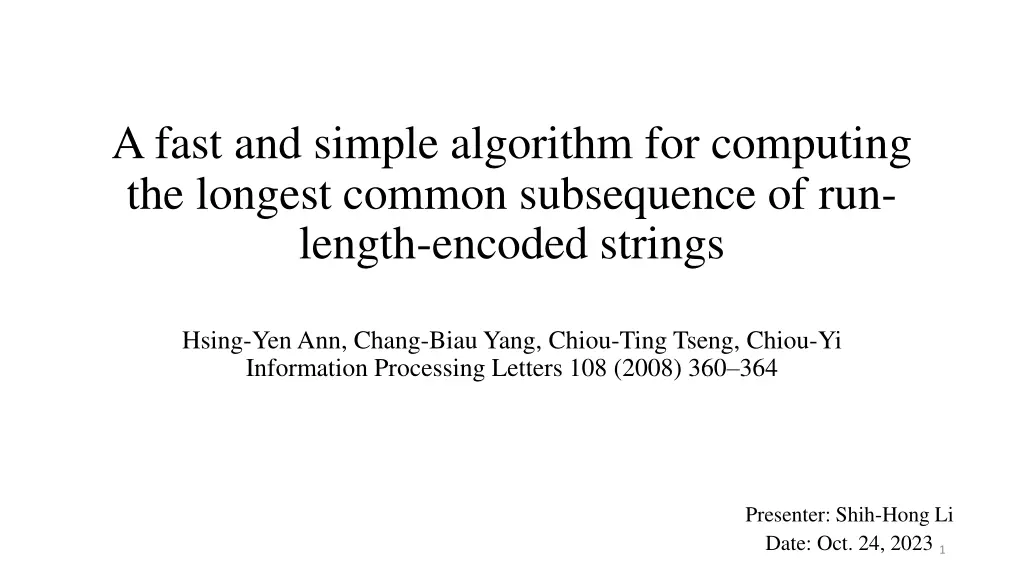
Efficient Algorithm for Longest Common Subsequence of Run-Length Encoded Strings
Discover a fast and simple algorithm for finding the longest common subsequence of run-length encoded strings with improved time complexity. This algorithm offers a significant enhancement over existing methods, making it a valuable tool in string processing tasks.
Download Presentation

Please find below an Image/Link to download the presentation.
The content on the website is provided AS IS for your information and personal use only. It may not be sold, licensed, or shared on other websites without obtaining consent from the author. If you encounter any issues during the download, it is possible that the publisher has removed the file from their server.
You are allowed to download the files provided on this website for personal or commercial use, subject to the condition that they are used lawfully. All files are the property of their respective owners.
The content on the website is provided AS IS for your information and personal use only. It may not be sold, licensed, or shared on other websites without obtaining consent from the author.
E N D
Presentation Transcript
A fast and simple algorithm for computing the longest common subsequence of run- length-encoded strings Hsing-Yen Ann, Chang-Biau Yang, Chiou-Ting Tseng, Chiou-Yi Information Processing Letters 108 (2008) 360 364 Presenter: Shih-Hong Li Date: Oct. 24, 20231
Abstract Let X and Y be two strings of lengths n and m, respectively, and k and l, respectively, be the numbers of runs in their corresponding run-length encoded forms. We propose a simple algorithm for computing the longest common subsequence of two given strings X and Y in O(kl + min{p1, p2}) time, where p1 and p2 denote the numbers of elements in the bottom and right boundaries of the matched blocks, respectively. It improves the previously known time bound O(min{nl,km}) and outperforms the time bounds O(kl log kl) or O((k + l + q)log(k + l + q)) for some cases, where q denotes the number of matched blocks. 2
Longest common subsequence(LCS) X=ttccca Y=tcccca LCS=tccca Time complecity:O(mn) 3
Run-length-encoded(RLE) X=x1x2 xn Y=y1y2 ym n=|X| , m=|Y| RLE String of X=RX1RX2 RXk,where all symblos RXiare the same, and the symbols in RXiand RXi+1, 1 i k-1, are different 4
The block & data structure If RXi= RYj ,then the block is called dark block ,otherwise it s called a light block M[i,j] : the value of LCS(RX1..i, RY1..j) W[i,j,r] : holds the value of the rth element on the bottom wall of block (i, j) 5
Forced path Traverse the dark block by strickly diagonal moves Traverse the light block by strictly horizontal (or vertical, respectively) moves 6
Properties of the LCS problem on RLE strings Dark block If Xar= Yar,then LCS(Xar,Yar) = LCS(X,Y)+r Light block If Xar Ybs,then LCS(Xar,Ybs) = max{LCS(Xar,Y), LCS(X,Ybs)} Merged light blocks LCS(Xar1Xar2 Xari,Yb1Yb2 Ybsj) = max{LCS(Xar1Xar2 Xari,Y),LCS(X Yb1Yb2 Ybsj)} 7
The Range Minimal Query (RMQ) problem Given an array of real numbers A[1..n], the range minimal (maximal) query (RMQ) problem is to answer the consequent queries on intervals An interval [i1,i2], 1 i1 i2 n, an RMQ asks to return the index of the minimal element in the interval A[i1,i2] Use Cartesian tree to reduce RMQ problem to O(1) Denote RMQmin(A, i1,i2),RMQmax(A, i1,i2) as minimal value and maximal value in interval A[i1,i2] 8
The basic idea(1/2) X=a3b6c4a12,Y=b3a8c4b8a5c4a4 Calculate W[4,7,2]: v0(dark block) = v1 + d1 v1(light block) = max{v2, v6} By expanding the values of the remaining elements on the forced path between u0and v0we get v2= v3+ d2 v3= max{v4, v7} v4= max{v5, v8} v5= u0+ d3 W[4,7,2] Then we get v0= max{v6+ d1 , v7+ (d1+ d2), v8+ (d1+ d2), u0+ (d1+ d2+ d3)} 9
The basic idea(2/2) v0= max{v6+ d1 , v7+ (d1+ d2), v8+ (d1+ d2), u0+ (d1+ d2+ d3)} {v6,v7,v8} are right corner of the block u0 is located at either the bottom wall of a light block or the lower right corner of a dark block Case 1: u0=max{u1, u2} u1 is bottom wall of the dark block The element need to be calculated in original dp lattice include the lower right corners of all blocks and the bottom blocks and bottom walls of the dark blocks 10
Algorithm(1/4) LCS(X,Y) preprocessing i:RXi P[i]:the index of the former run of RXiwhich contains the same symbol i C[j,r]:the number of ocurences of iin suffix Y (j,r)..m Li[j]:the values of the lower right corners of the blocks in row (i 1) plus the number of occurrences of ibetween the corners to the right end of Y, Li[j]=M[i-1,j]+Ci[j,mj] Hi[j,r]: points out the head of the forced path corresponding to (i, j,r) 11
Algorithm(2/4) LCS(X,Y) If block at light block :M[i,j] = max{M[i-1,j], M[i,j-1]} If block at dark block : ComputeWall(i,j) M[i,j] = W[i,j,mj] 12
Algorithm(3/4) ComputeWall(i,j): If forced path is never across on row (i 1): W[i,j,r] = RMQmax(Li,0,j-1)-Ci[j,r] Else: ?1 = RMQmax(Li,j ,j-1)-Ci[j,r] If forced path is a lower right corner of a block: ?2 = M[i-1,j ]+ni Else: ?2 = max{M[i-1,j -1], W[i ,j ,r ]}+ni W[i,j,r] =max{?1,?2 } 13
Algorithm(4/4) Time complexity: LCS(X,Y) Preprocessing:O(min(P1,P2)) P1 :the numbers of elements on the bottom and P2 right boundaries of the dark blocks If block at light block :O(1) If block at dark block : ComputeWall(i,j)(O(1)) Time complexity : O(kl+min(P1,P2)) 14
Longest common subsequence with run- length-encoded(a) X=ttccca(t2c3a1) Y=tcccca(t1c4a1) LCS=tccca Time complecity: O(nl+mk) t t c c c a 0 0 0 0 0 0 0 t 0 1 1 1 1 1 1 c 0 1 2 2 c 0 1 3 3 c 0 1 4 4 4 c 0 1 1 2 3 4 a 0 1 1 2 3 4 5 16
Longest common subsequence with run- length-encoded(c) X=ttccca(t2c3a1) Y=tcccca(t1c4a1) LCS=tccca Time complecity: O(kl+min(X,Y)) t t c c c a 0 0 0 0 0 0 0 t 0 1 1 1 1 c 0 c 0 c 0 c 0 1 2 3 4 4 a 0 1 4 5 17
Thanks 18
